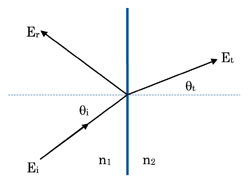Optipedia • SPIE Press books opened for your reference.
Fresnel Reflectivity
Excerpt from Field Guide to Optical Lithography
Consider light intersecting the plane interface between two materials,  numbered 1 and 2, with an incident electric field Ei, a reflected electric field Er, and a transmitted electric field Et. The transmission and reflection coefficients are functions of the angle of incidence and the polarization of the incident light. If θi is the incident (and reflected) angle and θt is the transmitted angle, then the electric field reflection and transmission coefficients are given by the Fresnel formulae.
numbered 1 and 2, with an incident electric field Ei, a reflected electric field Er, and a transmitted electric field Et. The transmission and reflection coefficients are functions of the angle of incidence and the polarization of the incident light. If θi is the incident (and reflected) angle and θt is the transmitted angle, then the electric field reflection and transmission coefficients are given by the Fresnel formulae.

where nj = nj +iκj = the complex index of refraction of material j. Here, ║ represents an electric field vector that lies parallel to the plane defined by the direction of the incident light and a normal to the material interface. Other names for ║ polarization include p polarization and TM (transverse magnetic) polarization. The polarization denoted by ┴ represents an electric field vector that lies in a plane perpendicular to that defined by the direction of the incident light and a normal to the surface. Other names for ┴ polarization include s polarization and TE (transverse electric) polarization. Note that

C. A. Mack, Field Guide to Optical Lithography, SPIE Press, Bellingham, WA (2006).
View SPIE terms of use.

